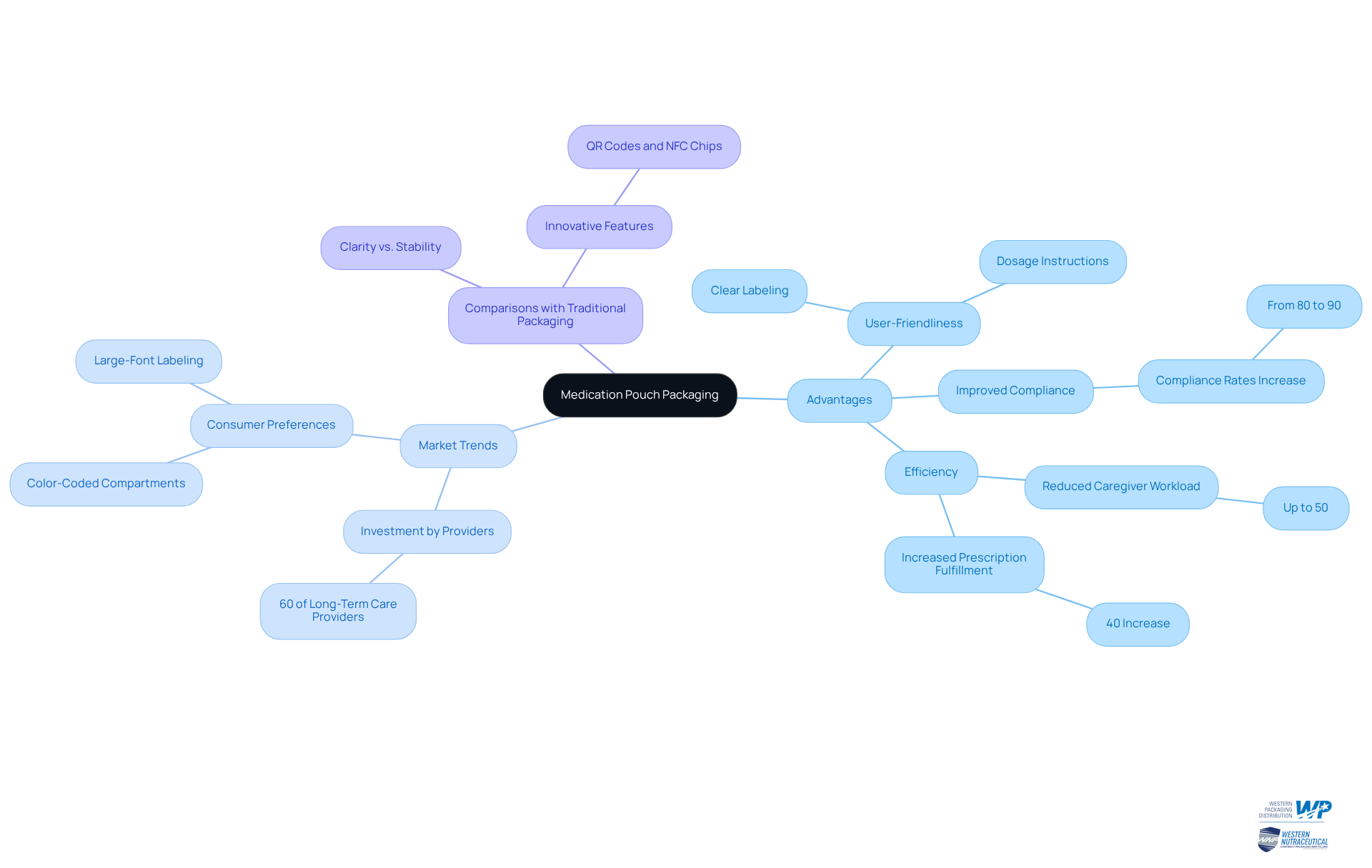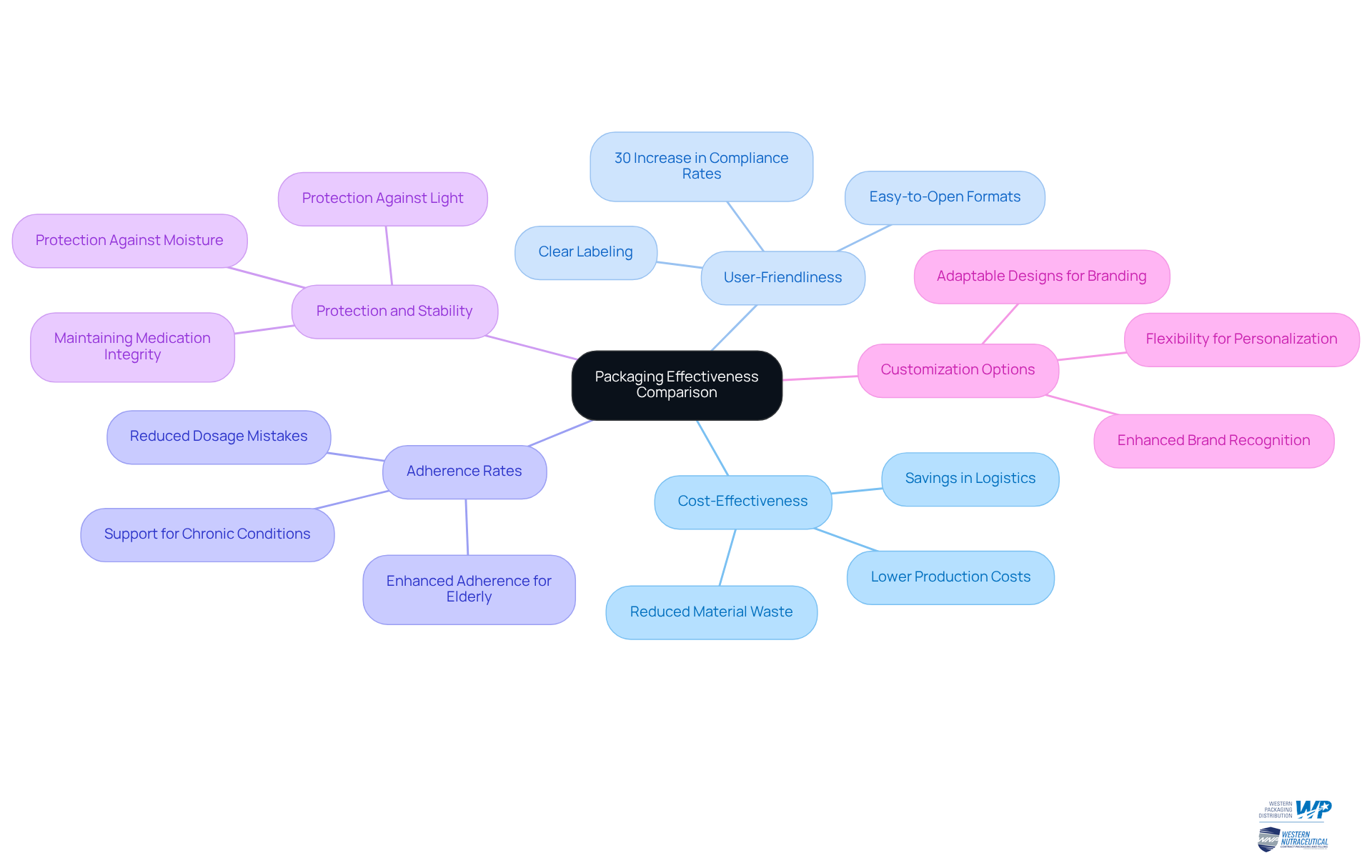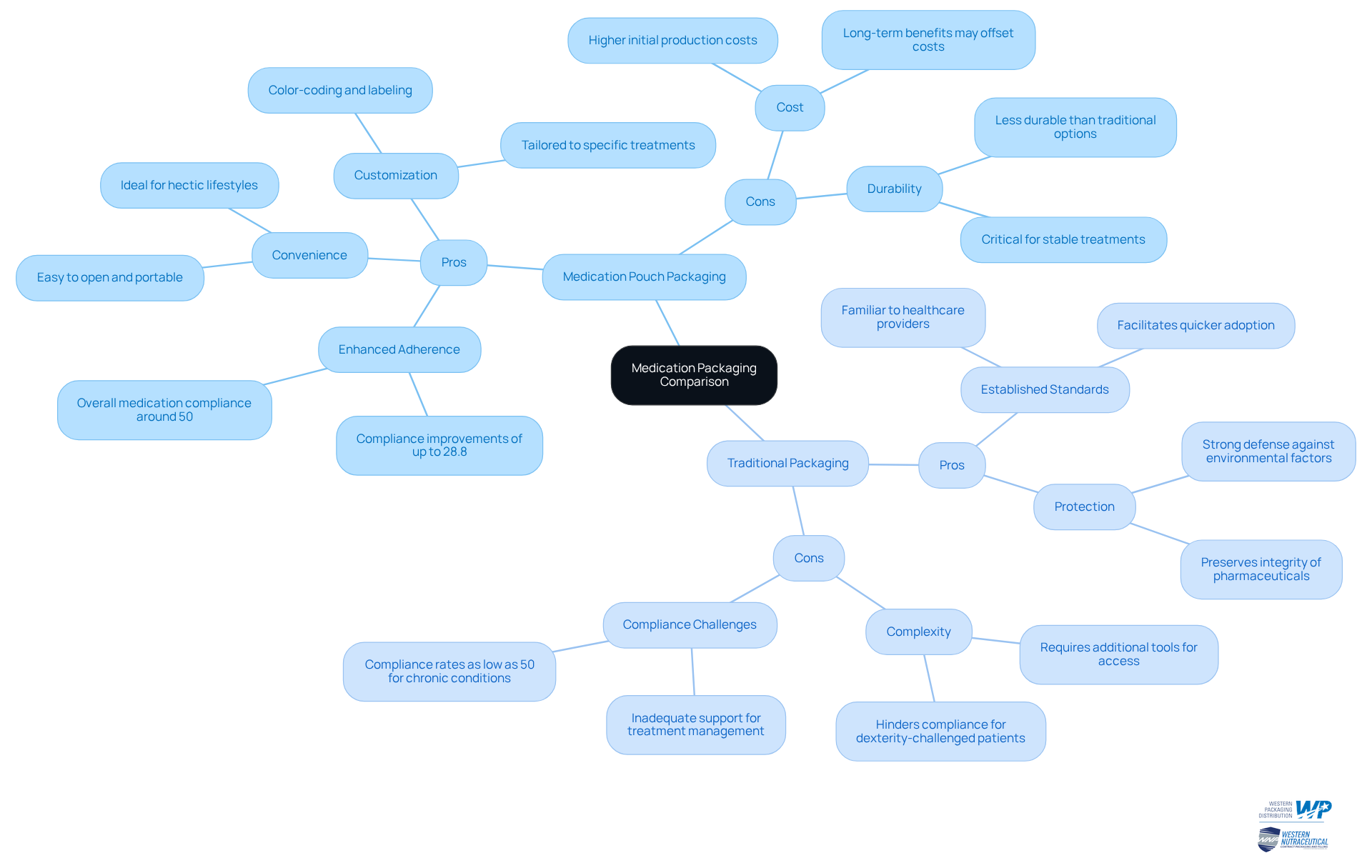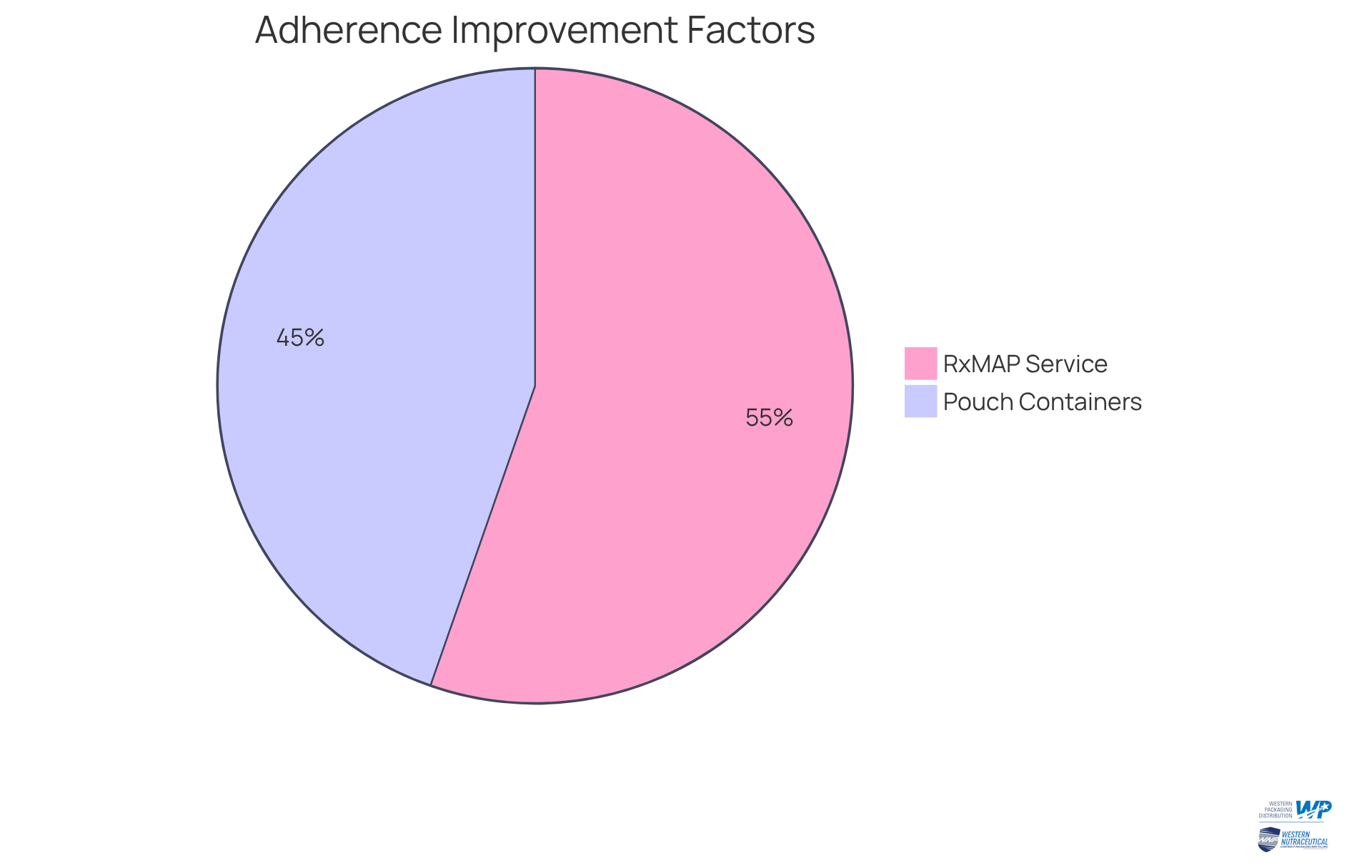Overview
Medication pouch packaging presents substantial advantages over traditional packaging methods, primarily by enhancing patient adherence and convenience through user-friendly designs and clear labeling. Compliance rates can improve dramatically with pouch packaging; studies indicate adherence increases from 80% to 90%. Furthermore, 60% of long-term care providers are adopting this innovative approach, streamlining medication administration and reducing caregiver workload. This shift not only underscores the effectiveness of pouch packaging but also highlights its role in improving healthcare outcomes. As the industry evolves, embracing such advancements is essential for enhancing patient care and operational efficiency.
Introduction
Medication pouch packaging is revolutionizing the pharmaceutical landscape, providing a modern alternative to traditional methods such as pill bottles and blister packs. With a significant increase in patient adherence rates and a growing preference among healthcare providers, these innovative pouches are not merely a trend; they signify a substantial shift towards more user-friendly medication management. However, as manufacturers evaluate the benefits alongside potential drawbacks, one must consider: can the advantages of medication pouch packaging genuinely surpass the established reliability of traditional containers in ensuring patient compliance and safety?
Understanding Medication Pouch Packaging and Traditional Packaging
Medication pouch packaging signifies a transformative leap in the pharmaceutical industry, providing flexible, sealed pouches that hold individual doses of medication. These pouches are meticulously designed for user-friendliness, often featuring clear labeling and dosage instructions that significantly enhance adherence. In contrast, traditional containment methods—such as pill bottles, blister packs, and vials—have long dominated the market. Although conventional containers effectively protect drugs and ensure stability, they frequently lack the convenience and clarity offered by pouch containers.
The shift towards medication pouch packaging is driven by numerous substantial advantages. Research indicates that compliance rates among patients utilizing medication pouch packaging surged from 80% to 90%, underscoring the effectiveness of this approach in managing complex treatment plans. Moreover, nearly 60% of long-term care providers are investing in medication pouch packaging, recognizing its potential to streamline medication administration and reduce caregiver workload by up to 50%.
Real-world examples further underscore the advantages of pouch containers. In 2025, Parata Systems implemented robotic adherence container units in over 50 regional pharmacies, yielding a 40% increase in prescription fulfillment efficiency and a 30% decrease in dispensing errors. This exemplifies how innovative solutions, such as medication pouch packaging offered by Western Packaging, can enhance operational efficiency while bolstering safety for individuals.
Current trends in the utilization of traditional medication containers reveal a growing preference for medication pouch packaging as an advanced solution. Over 45% of new product launches in 2025 incorporate color-coded compartments and large-font labeling, specifically designed to meet the needs of elderly and visually impaired users. This evolution reflects a broader industry shift towards user-friendly designs, particularly medication pouch packaging, that prioritize patient engagement and adherence.
As industry specialists assert, efficient wrapping serves as a critical marketing tool, with 70% of consumers purchasing items based solely on their presentation. This underscores the importance of adapting methods to meet evolving consumer expectations and regulatory standards. The ongoing integration of technology, such as QR codes and NFC chips in medication pouch packaging for new adherence solutions, further illustrates the sector's commitment to enhancing healthcare management and patient outcomes. The medication pouch packaging market is projected to reach USD 1.11 billion in 2025, underscoring the increasing significance of pouch solutions.

Comparison Criteria: Evaluating Packaging Effectiveness
When comparing traditional packaging and medication pouch packaging, several key criteria emerge:
-
Cost-Effectiveness: Pouch packaging often presents lower production costs and can lead to significant savings in logistics. The streamlined design of pouches reduces material waste and simplifies the supply chain, making them a more economical choice for manufacturers.
-
User-Friendliness: Pouches are designed with user accessibility in mind, featuring clear labeling and easy-to-open formats. This design improves the user experience, enabling patients to handle their treatments more effectively. Research shows that easy-to-use containers can enhance compliance rates by as much as 30%.
-
Adherence Rates: The impact of container style on treatment adherence is considerable. Medication pouch packaging, especially in unit-dose formats, has demonstrated the ability to reduce dosage mistakes and enhance adherence, particularly among the elderly and individuals with chronic conditions.
-
Protection and Stability: Pouches provide excellent protection against environmental factors such as moisture and light, which can compromise medication integrity. This is crucial for maintaining the efficacy of sensitive pharmaceuticals.
-
Customization Options: Pouch wrapping provides enhanced flexibility for personalization, enabling producers to adapt designs to satisfy particular consumer needs or branding criteria. This adaptability can enhance brand recognition and customer engagement.
These criteria establish a thorough framework for assessing the strengths and weaknesses of each type of container, assisting manufacturers in making informed choices that align with their operational objectives and consumer needs.

Pros and Cons of Medication Pouch Packaging vs. Traditional Packaging
Pros and Cons of Medication Pouch Packaging vs. Traditional Packaging
Medication Pouch Packaging
Pros:
- Enhanced Adherence: Medication pouches can be designed with built-in reminders and clear instructions, significantly improving patient compliance. Research shows that individuals utilizing blister containers experienced compliance enhancements of up to 28.8% over 12 months, underscoring the potential of customized container solutions. Furthermore, overall medication compliance is estimated at around 50%, emphasizing the urgent need for effective packaging solutions to improve these rates.
- Convenience: Pouches are easy to open and portable, making them ideal for individuals who are often on the move. Their design allows for easy access, which can be vital for maintaining compliance in hectic lifestyles.
- Customization: Pouches can be tailored to specific treatments and individual patient needs, enhancing the user experience. This personalization can involve color-coding and labeling that correspond with treatment schedules, further aiding compliance.
Cons:
- Cost: The initial production costs for medication pouches may be higher compared to traditional packaging options. However, the long-term benefits of improved adherence and reduced healthcare costs associated with nonadherence—estimated at over $100 billion annually in the United States—can offset these initial expenses.
- Durability: While pouches offer flexibility, they may be less durable than glass or plastic bottles, potentially affecting long-term storage. This aspect is critical for treatments that require stable environments to maintain efficacy. A case study on the effectiveness of drug reminder containers highlights its role in managing health parameters, indirectly supporting the argument for durability in maintaining treatment efficacy.
Traditional Packaging
Pros:
- Established Standards: Traditional packaging formats, such as pill bottles and blister packs, are familiar to healthcare providers and patients, leading to ease of use. This familiarity can facilitate quicker adoption and compliance among users.
- Protection: Bottles and blister packs offer strong defense against environmental factors, ensuring that substances remain effective over time. The safeguarding features of conventional containers are vital for preserving the integrity of delicate pharmaceuticals.
Cons:
- Complexity: Accessing medications from traditional packaging may require additional tools, such as scissors for blister packs, complicating the process for some patients. This complexity can hinder compliance, particularly for those with dexterity challenges.
- Compliance Challenges: Conventional containers frequently do not adequately assist with treatment management, particularly for individuals handling intricate regimens. Studies indicate that compliance rates can be as low as 50% among individuals with chronic conditions, emphasizing the need for more supportive container solutions.
In summary, while medication pouch packaging designs provide considerable benefits regarding compliance and personalization, conventional containers continue to be a dependable option due to their established standards and protective features. Manufacturers must weigh these factors, including cost implications and durability, when considering container solutions for their products.

Impact on Medication Adherence: A Comparative Analysis
Research underscores the crucial role of design in enhancing treatment compliance. Medication pouch packaging, recognized for its user-friendly design and clear labeling, has demonstrated a significant improvement in compliance rates. Notably, 71% of individuals reported being more inclined to take their prescriptions on time when utilizing pouch containers, while 88% indicated they skipped fewer doses after engaging with the RxMAP service. This highlights the effectiveness of pouch containers in fostering compliance.
Conversely, traditional containment methods, such as bottles and blister packs, frequently lead to confusion, particularly for individuals managing multiple treatments. The challenges associated with opening these conventional packages can hinder adherence to treatment schedules.
Experts assert that innovative container solutions are vital for advancing medication compliance through cutting-edge technologies that enhance patient involvement and interaction. Consequently, manufacturers must prioritize the impact of containers on compliance when selecting the most effective options for their products.
Nonetheless, it is essential to acknowledge the challenges present in the compliance container market, including high costs and stringent regulatory standards, which may limit the availability of these solutions. Real-world case studies further exemplify the positive influence of medication pouch packaging on patient adherence, reinforcing the necessity for manufacturers to consider these factors in their packaging strategies.

Conclusion
The evolution of medication pouch packaging signifies a pivotal advancement in the pharmaceutical sector, presenting manufacturers with a contemporary solution that enhances patient adherence and simplifies medication management. Unlike traditional packaging methods, which can obstruct compliance due to their complexity, pouch packaging distinguishes itself through its user-friendly design, clear labeling, and improved accessibility. This transition not only addresses the demands of today’s consumers but also aligns with the industry's objective of fostering better health outcomes.
Throughout this article, we have highlighted key advantages of medication pouch packaging, including:
- Increased adherence rates
- Cost-effectiveness
- Customization options
Real-world examples illustrate how these pouches can streamline medication administration and minimize errors, while research indicates a significant improvement in compliance among users, particularly the elderly and those with chronic conditions. In contrast, traditional packaging methods, despite their established reliability, often fall short in promoting effective treatment adherence.
Ultimately, the shift towards medication pouch packaging is not merely a trend but a necessary evolution within the pharmaceutical industry. As manufacturers increasingly adopt innovative packaging solutions, the emphasis on patient engagement and adherence will only intensify. By prioritizing user-friendly designs and leveraging advanced technology, the sector can enhance medication management and substantially improve health outcomes. Embracing this change is essential for manufacturers striving to meet the evolving needs of patients and healthcare providers alike.
Frequently Asked Questions
What is medication pouch packaging?
Medication pouch packaging refers to flexible, sealed pouches that hold individual doses of medication, designed for user-friendliness with clear labeling and dosage instructions.
How does medication pouch packaging compare to traditional packaging?
Traditional packaging methods, like pill bottles and blister packs, effectively protect drugs but often lack the convenience and clarity of pouch containers, which enhance adherence and usability.
What are the benefits of medication pouch packaging?
Medication pouch packaging has been shown to increase compliance rates among patients from 80% to 90% and can reduce caregiver workload by up to 50% for long-term care providers.
Are there any real-world examples of the effectiveness of medication pouch packaging?
Yes, in 2025, Parata Systems implemented robotic adherence container units in over 50 pharmacies, resulting in a 40% increase in prescription fulfillment efficiency and a 30% decrease in dispensing errors.
What trends are emerging in the packaging of medications?
There is a growing preference for medication pouch packaging, with over 45% of new product launches in 2025 featuring color-coded compartments and large-font labeling to accommodate elderly and visually impaired users.
How important is packaging design in the pharmaceutical industry?
Efficient wrapping is a critical marketing tool, with 70% of consumers making purchases based on presentation, highlighting the need for packaging that meets consumer expectations and regulatory standards.
What technological advancements are being integrated into medication pouch packaging?
Technology such as QR codes and NFC chips is being incorporated into medication pouch packaging to enhance adherence solutions and improve healthcare management.
What is the projected market size for medication pouch packaging?
The medication pouch packaging market is projected to reach USD 1.11 billion in 2025, indicating its growing significance in the pharmaceutical industry.




